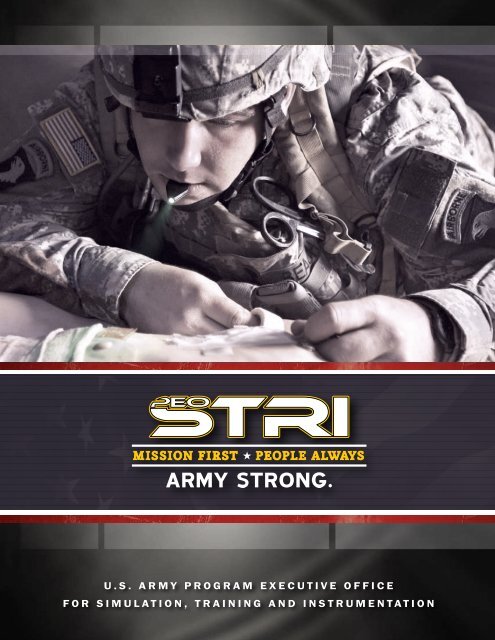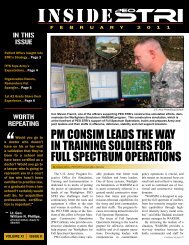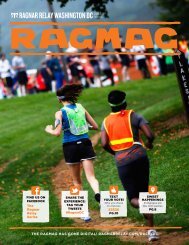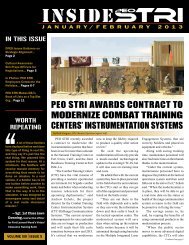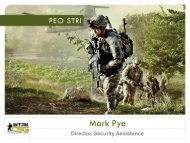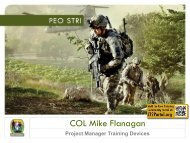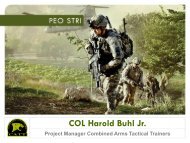Inside STRI Special Edition January - February 2009 (PDF)
Inside STRI Special Edition January - February 2009 (PDF)
Inside STRI Special Edition January - February 2009 (PDF)
Create successful ePaper yourself
Turn your PDF publications into a flip-book with our unique Google optimized e-Paper software.
U.s. army Program Executive Office<br />
for Simulation, Training and Instrumentation
Contacts<br />
Program Executive Officer<br />
Dr. James Blake<br />
407-384-3502<br />
Deputy Program Executive Officer<br />
Col. Ken Wheeler<br />
407-384-3524<br />
Business Operations Executive<br />
Mr. Rob Reyenga<br />
407-384-3505<br />
Customer Support Executive<br />
Mr. Pete Marion<br />
407-384-3799<br />
Project Support Executive<br />
Ms. Traci Jones<br />
407-384-3770<br />
Project Manager Combined Arms<br />
Tactical Trainers (PM CATT)<br />
Col. Francisco Espaillat<br />
407-384-3600<br />
Project Manager Constructive<br />
Simulation (PM ConSim)<br />
Col. Karen Saunders<br />
407-384-3651<br />
Program Manager Field Operations<br />
(PM Field OPS)<br />
Mr. Russ McBride<br />
407-384-3690<br />
Project Manager Future Force<br />
(Simulation) (PM FF(S))<br />
Jeff Simons<br />
407-243-3448<br />
Project Manager Instrumentation,<br />
Targets and Threat Simulators<br />
(PM ITTS)<br />
Col. David Lockhart<br />
407-384-5250<br />
Project Manager Training Devices<br />
(PM TRADE)<br />
Col. Fred Mullins<br />
407-384-5200<br />
Principal Assistant Responsible for<br />
Contracting (PARC)<br />
Ken Tedeschi<br />
407-384-5113<br />
Who We Are<br />
What We Do<br />
How We Do It<br />
Mission<br />
Critical Tasks<br />
PEO <strong>STRI</strong> At a Glance<br />
Military, government civilians and contractor teams working together.<br />
Member of Team Orlando: Central Florida military, industry and academic institutions.<br />
Acquisition agency executing a $3.5 billion budget in support of the Army.<br />
Develop, acquire, field and sustain cutting-edge training and testing devices.<br />
Support multi-domain training in the live, virtual, constructive and gaming areas.<br />
Charter emphasizes a joint perspective to support U.S. defense initiatives.<br />
Training aids, devices and simulations supporting U.S. and coalition service members.<br />
An Army Acquisition Center of Excellence with Head of Contracting Activity authority.<br />
To provide responsive interoperable simulation, training, and testing solutions and<br />
acquisition services for the Warfighters and the nation.<br />
Provide simulation, training and testing products and services.<br />
Expand beyond the traditional products and services.<br />
Provide an integrated and interoperable infrastructure.<br />
Shape a world-class workforce with acquisition, functional and leadership skills.<br />
Provide a full range of contracting and acquisition services for effective, efficient and<br />
responsive life-cycle management.<br />
Implement U.S. Army policy for acquisition of system training devices.<br />
Public Affairs Office<br />
407-384-5224<br />
Industry Customer Contact<br />
407-384-3773<br />
www.peostri.army.mil<br />
General Information<br />
407-384-3500
James T. Blake, Ph.D.<br />
Program Executive Officer<br />
U.S. Army Program Executive Office for<br />
Simulation, Training and Instrumentation<br />
Dr. James T. Blake serves as the<br />
program executive officer for the U.S.<br />
Army PEO <strong>STRI</strong> and head of contracting<br />
activity for Army simulation, training<br />
and instrumentation. He is responsible<br />
for providing materiel solutions and<br />
services in modeling, simulation, training<br />
and test-instrumentation to support the<br />
Warfighter.<br />
Blake retired as an Army colonel after<br />
a distinguished military career. In his last<br />
assignment, Blake was the Army’s senior<br />
uniformed scientist. He is a graduate of<br />
the U.S. Army Command and General<br />
Staff College, the Defense Systems<br />
Management College, and the U.S. Army<br />
War College. He has a Ph.D. in computer<br />
science from Duke University.<br />
Following his military career,<br />
Blake held several technical and<br />
executive positions in industry before<br />
joining academia where he served as<br />
a senior research scientist at Texas<br />
A&M University. While at Texas A&M,<br />
Blake joined the Simulation, Training<br />
and Instrumentation Command as the<br />
program manager for the Institute for<br />
Creative Technologies.<br />
In March 2003, he became a member<br />
of the Senior Executive Service. From<br />
March 2003 until June 2005, Blake served<br />
as the deputy program executive officer<br />
for PEO <strong>STRI</strong>.<br />
A Message from the PEO<br />
We are in an era of persistent conflict, so therefore it is clear that our Army and its<br />
capability will be in high demand for many years to come.<br />
At PEO <strong>STRI</strong>, we are truly cognizant of this state of affairs, and as such, we are preparing<br />
the Soldier of today, and the Soldier of tomorrow, with the best available training enablers.<br />
Whether our force is engaged in peace keeping missions, counterinsurgency, or major<br />
combat operations, we pledge to provide timely, realistic, readily-available, cost efficient<br />
and safe training to America’s greatest asset, its Warfighters.<br />
When we learned of the critical need for operator training for Mine Resistant Ambush<br />
Protected vehicles, PEO <strong>STRI</strong> quickly responded by getting MRAP driver and egress trainers<br />
into the hands of our Warfighters.<br />
Similarly, we have become strikingly aware of the benefits that gaming technology<br />
provides our younger Soldiers in honing their decision-making, communication and team<br />
building skills. In response, PEO <strong>STRI</strong> replaced the original game we were fielding with<br />
one that is more attuned to the situations our Soldiers face on today’s battlefield.<br />
In order to get these training enablers to our Warfighters in an accelerated manner,<br />
we are committed to an efficient approach to Army acquisition. Our recent award of the<br />
second <strong>STRI</strong> Omnibus Contract, or STOC II, is a clear example of our commitment.<br />
PEO <strong>STRI</strong> is one element of the Army’s acquisition team in which we work closely<br />
with our combat developers to find solutions to procurement challenges. Without a doubt,<br />
we could not accomplish this large task without a highly professional and well-educated<br />
workforce. In order to keep our team at an optimal level, we have created an Acquisition<br />
Academy to introduce new employees to the federal workforce through an 11-week<br />
Army internship program.<br />
In the next few pages, you will find many examples of what derives from a strong<br />
workforce coupled with an unwavering dedication to the Warfighter. Mission first, people<br />
always. Army Strong!
New MRAP Vehicles<br />
Call for New Training<br />
As the Mine Resistant Ambush Protected<br />
(MRAP) family of fighting vehicles became<br />
the highest-sought mode of transportation<br />
in the combat zone, PEO <strong>STRI</strong> responded<br />
with a driver and egress trainer to prepare<br />
Soldiers for the new vehicle they would be<br />
operating.<br />
Specifically, Soldiers at Camp Shelby,<br />
Miss., were the first to receive the driver<br />
trainer Jan. 27, <strong>2009</strong>, and Warfighters in Iraq<br />
will be the first to get the egress trainer the<br />
end of <strong>February</strong> <strong>2009</strong>. In total, 20 driver<br />
trainers are expected to be delivered over<br />
the next year, and nearly 30 egress trainers<br />
are scheduled to be fielded in the coming<br />
months.<br />
The driver trainer, called the Common<br />
Driver Trainer MRAP variant, “trains critical<br />
driver tasks in a virtual simulator that are<br />
too dangerous or infrequently trained in<br />
the live training environment,” said Lt. Col.<br />
Charlie Stein, product manager for ground<br />
combat tactical trainers.<br />
Some of the dangerous situations<br />
that Soldiers are currently encountering<br />
in theater that this trainer takes into<br />
consideration are bad driving conditions<br />
like dilapidated roads and weak bridges,<br />
combat conditions like roadside bombs or<br />
ambushes, and mere driver error.<br />
While the training mission is relatively<br />
the same for all the Soldiers using the<br />
simulation, the type of vehicle they will<br />
be operating in the war zone could very<br />
well vary as there are a handful of different<br />
MRAP vehicles in Iraq and Afghanistan.<br />
As a result, PEO <strong>STRI</strong> will field five types<br />
of MRAP vehicles: a mine-resistant light<br />
armored vehicle (RG-33L), a multipurpose<br />
mine-protected vehicle (RG-31), an<br />
armored fighting vehicle (MaxxPro), an<br />
armored vehicle with a V-hull design based<br />
on the Family of Medium Tactical Vehicles<br />
(Caiman), and the Marines’ armored<br />
fighting vehicle (Cougar).<br />
“With the driver trainer, we are<br />
U.S. Army Photo/Norbert Granchi<br />
The Mine Resistant Ambush Protected (MRAP) vehicles are a family of armored fighting vehicles designed to increase<br />
survivability of improvised explosive device attacks and ambushes. This is a photo of an MRAP vehicle located at<br />
Firebase Ripley in the southern region of Afghanistan.<br />
focusing on the fidelity of the vehicle<br />
and its dynamics—the point at which the<br />
vehicle will rollover,” Stein explained. “To<br />
accurately do this, we’ve worked with<br />
the subject matter experts in this field:<br />
equipment manufacturers and Soldiers<br />
who’ve operated an MRAP in theater.”<br />
The CDT-MRAP variant is based on PEO<br />
<strong>STRI</strong>’s original driver trainer for the Stryker<br />
vehicle and the follow-on improvements<br />
made with the tank variant.<br />
“It was beneficial to model the new<br />
MRAP driver trainers on previous driver<br />
trainers because we were able leverage<br />
the same motion base and instructor<br />
stations on the Stryker and tank variants,”<br />
Stein said.<br />
“This gives units the flexibility to change<br />
cabs and train on the MRAP, Stryker, tank,<br />
and some day in the near future, a tactical<br />
wheeled vehicle,” he noted.<br />
Much like the Stryker and tank driver<br />
trainers, the MRAP trainer also includes<br />
a motion platform, image generators, an<br />
instructor/operator station and an after<br />
action review station. Most importantly, the<br />
Common Driver Trainer family of driving<br />
simulations is modular, interchangeable and<br />
allows multiple variants to be compatible<br />
with the common training platform.<br />
“All these qualities are important<br />
because they contribute to maintainability,<br />
sustainability and a cost-avoidance to the<br />
Army,” Stein said.<br />
As with the driver trainer, the egress<br />
trainer enables the Soldier to become<br />
proficient in tasks which cannot be taught<br />
in a live environment.<br />
The MRAP egress trainer is modeled on<br />
PEO <strong>STRI</strong>’s High Mobility Multipurpose<br />
Wheeled Vehicle Egress Assistance Trainer,<br />
and much like its predecessor, the “MRAP<br />
trainer proves to be an Army solution to<br />
an Army problem,” noted Dr. James Blake,<br />
program executive officer for PEO <strong>STRI</strong>.<br />
Many organizations within the Army<br />
came together to make both egress<br />
trainers a reality. The Tank-Automotive<br />
Research, Development and Engineering<br />
Center designed and built the prototype.<br />
The effort was funded by the Army and<br />
the Marines’ joint office, Program Manager<br />
MRAP.<br />
Once the prototype was certified for<br />
safety, the Red River Army Depot began<br />
production of the trainers based on the<br />
prototype.<br />
Continued on next page
Contracting Vehicle Positions PEO <strong>STRI</strong><br />
to Better Support U.S. and Coalition Troops<br />
PEO <strong>STRI</strong> granted 142 awards to more<br />
than 120 companies for the second <strong>STRI</strong><br />
Omnibus Contract, known as STOC II,<br />
Jan. 27, <strong>2009</strong>. STOC II, valued at $17.5<br />
billion over the next 10 years, serves as<br />
an efficient contracting vehicle in order to<br />
quickly get simulation and training products<br />
and services into the hands of U.S. and<br />
coalition service members.<br />
“STOC II is PEO <strong>STRI</strong>’s newest contract<br />
vehicle providing continued responsiveness<br />
to the Warfighter,” noted John Daniele,<br />
deputy customer support executive for<br />
PEO <strong>STRI</strong>. “It is positioned and structured<br />
to meet the demands of the current and<br />
future operating environments with<br />
relevant and responsive solutions for the<br />
nation.”<br />
Companies competing in STOC II were<br />
evaluated in two categories: the Full and<br />
Open Lot and the Partial Small Business<br />
Set Aside Lot. Small companies competing<br />
in the Full and Open Lot also had the<br />
opportunity to compete in the Partial Small<br />
Business Set-Aside Lot, and vice-versa.<br />
Two lots were established in order to<br />
enhance PEO <strong>STRI</strong>’s ability to achieve its<br />
small business goals.<br />
In response to the STOC II Request for<br />
Proposal, PEO <strong>STRI</strong> evaluated 158 compliant<br />
proposals in which 127 proposals (60 large<br />
companies and 67 small companies) were<br />
entertained in the Full and Open Lot, and<br />
98 proposals were assessed in the Partial<br />
Small Business Set-Aside Lot.<br />
The proposals were evaluated based on<br />
four core factors detailed in the Request for<br />
Proposal: past performance, management,<br />
small business participation plan (applicable<br />
only to the large companies in the Full and<br />
Open Lot) and cost/price.<br />
“The overall purpose of STOC II is to<br />
have highly-qualified contractors on-hand<br />
to rapidly satisfy the needs of our nation’s<br />
Warfighters,” explained Brian Murphy, the<br />
PEO <strong>STRI</strong> contracting officer responsible<br />
for STOC II.<br />
Existing STOC I contracts—which<br />
were awarded in four different categories:<br />
Live, Virtual, Constructive and Test-<br />
Instrumentation—remain a viable solution<br />
during the transition period until each<br />
respective domain expires. The first<br />
domain, Test-Instrumentation, expires late<br />
<strong>February</strong>, <strong>2009</strong>. The remaining domains<br />
expire March <strong>2009</strong>.<br />
“Leveraging experience with the<br />
STOC I contract, STOC II accommodates<br />
emerging requirements, technologies and<br />
innovation via access to an extensive array<br />
of industry and academia capabilities,”<br />
Daniele advised.<br />
Companies outside of STOC II will still<br />
be able to do business with PEO <strong>STRI</strong>.<br />
Murphy advises, “STOC II is just one tool<br />
in a contracting officer’s toolkit.” <br />
Mine Resistant Ambush Protected<br />
(MRAP) Vehicles Continued. . .<br />
Finally, PEO <strong>STRI</strong> is responsible for<br />
getting the device into the hands of the<br />
Warfighters in which the initial fielding<br />
schedule calls for 25 egress trainers to<br />
go to the Army in the theater of combat<br />
operations. Additionally, three devices will<br />
go to the Marines.<br />
“Without a doubt, MRAP driver and<br />
egress trainers are important because<br />
many of the Soldiers and Marines driving<br />
MRAP vehicles down range won’t get<br />
the opportunity to operate these vehicle<br />
until they’re in the theater of combat<br />
operations. We are giving our Warfighters<br />
the opportunity to train prior to getting in<br />
the seat,” Stein said. <br />
U.S. Army Photo/Red River Army Depot<br />
PEO <strong>STRI</strong>’s Common Driver Trainer MRAP variant provides Soldiers the opportunity to train on a simulated vehicle<br />
before operating the actual MRAP in Iraq or Afghanistan. The first MRAP driver trainer, pictured above, was<br />
delivered to Camp Shelby, Miss., <strong>January</strong> 2008. A total of 20 trainers are expected to be fielded in <strong>2009</strong>.
Army Takes Gaming to the Next Level<br />
Soldiers all over the United States, and<br />
even in three locations abroad, will soon<br />
be training on the Army’s newest game,<br />
Virtual Battlespace 2, or VBS-2 for short. In<br />
fact, Soldiers at Fort Hood, Texas, were the<br />
first to receive the Army’s official game for<br />
training in early <strong>February</strong> <strong>2009</strong>.<br />
PEO <strong>STRI</strong>, will continue the fielding of<br />
VBS-2 to Forts Bragg, N.C., Carson, Colo.,<br />
and Lewis, Wash.., through March <strong>2009</strong>.<br />
“The Army takes gaming technology<br />
seriously because small unit leaders are<br />
highly receptive to using a technology<br />
they have grown up with. Small units use<br />
games for training to refine decision-making<br />
skills associated with shoot, move and<br />
communicate collective tasks in a mounted<br />
or dismounted environment,” explained Lt.<br />
Col. Gary Stephens, product manager for<br />
air and command tactical trainers.<br />
VBS-2, the Army’s next generation of<br />
games for training, was procured by PEO<br />
<strong>STRI</strong> in response to an operational needs<br />
statement from the U.S. Army Forces<br />
Command. The contract was awarded<br />
Dec. 19, 2008 to Laser Shot, Inc., for $17.7<br />
million over the next five years. In addition<br />
to the contract award for software, PEO<br />
<strong>STRI</strong> awarded a $6 million contract to<br />
CDW-G for the actual computers.<br />
From <strong>February</strong> to September <strong>2009</strong>,<br />
PEO <strong>STRI</strong> will field 70 training systems<br />
to 53 locations across the continental<br />
United States, Germany, Italy and South<br />
Korea. Each system consists of 52 laptop<br />
computers and the associated peripheral<br />
gaming equipment.<br />
Previous to VBS-2, PEO <strong>STRI</strong> fielded<br />
the original game for training Soldiers,<br />
DARWARS Ambush!. The effort fielded<br />
3,000 copies of the game to the Army,<br />
Navy, Air Force, Marines, Coast Guard and<br />
Department of Homeland Defense since<br />
2006.<br />
Much like DARWARS Ambush!, VBS-2 is<br />
a first-person shooter game that portrays<br />
a realistic operational environment. In<br />
addition, both games offer an after action<br />
review capability.<br />
The new game, however, has significant<br />
improvements over its predecessor.<br />
First, the geographical terrain database<br />
has increased from 13 kilometers by 13<br />
kilometers to 100 kilometers by 100<br />
kilometers. “The larger geographical space<br />
better represents the current operational<br />
environment,” Stephens said.<br />
Secondly, VBS-2 offers a threedimensional<br />
mission editor that allows users<br />
to make changes to the training scenario in<br />
real time. Additionally, a more user-friendly<br />
mission editor permits users to easily create<br />
training scenarios that are designated to<br />
meet training objectives.<br />
Furthermore, the new game includes<br />
a Distributed Interactive Simulation-High<br />
Level Architecture interface that allows the<br />
system to interoperate with other virtual,<br />
constructive and battle command systems.<br />
While PEO <strong>STRI</strong> is responsible for<br />
acquiring and fielding the game, the Training<br />
and Doctrine Command Training Capabilities<br />
Manager for Gaming is responsible for<br />
determining requirements and what skills<br />
Soldiers should learn from the game.<br />
The game replicates what Soldiers<br />
encounter on today’s battlefield so that<br />
users can practice a multitude of kinetic<br />
and non-kinetic skills—everything from<br />
operating in an urban terrain and reacting to<br />
ambush operations to cultural and language<br />
awareness, explained Col. Mark McManigal,<br />
the TRADOC capabilities manager for<br />
gaming. <br />
Did You know?<br />
One of the Army’s new field<br />
manuals, Training for Full<br />
Spectrum Operations, states that<br />
gaming is the use of technology<br />
employing commercial or<br />
government off-the-shelf, multigenre<br />
games in a realistic,<br />
semi-immersive environment to<br />
support education and training.<br />
Although the Army has used<br />
games informally for many<br />
years, it had never established<br />
a formal sustainable program<br />
for the acquisition and use of<br />
games until April 2008. VBS-<br />
2 was developed as the first<br />
official Army game to train and<br />
educate Soldiers, leaders and<br />
organizations.<br />
U.S. Army Photo/Training and Doctrine Command Capabilities Manager for Gaming Photo<br />
PEO <strong>STRI</strong> began fielding Virtual Battlespace 2, the Army’s newest computer game for training, <strong>February</strong> 2008. The<br />
game replicates the environment and situations that Soldiers are facing in the current theater of combat operations.
Acquisition Academy: Helping to Improve<br />
the Way New Employees are Introduced<br />
to the Federal Government Workforce<br />
Don’t Miss PEO <strong>STRI</strong> at<br />
the Following Events<br />
In October 2008, PEO <strong>STRI</strong> graduated<br />
its first Acquisition Academy class of 21<br />
contract specialist interns in which all of<br />
the students successfully completed the<br />
coursework and earned themselves a<br />
position in the organization’s Acquisition<br />
Center. Due to the success of the inaugural<br />
class, PEO <strong>STRI</strong> will kick-off the second<br />
Acquisition Academy class March 2008.<br />
While the first class focused primarily<br />
on Army contracting, the subsequent<br />
course covers an array of acquisitionrelated<br />
career fields: engineering, budget<br />
and program analysis, acquisition logistics,<br />
program management and contracting. As<br />
such, nearly 20 Acquisition Academy interns<br />
were hired into a specific career path.<br />
“For the second class, we wanted<br />
to create an integrated product team<br />
environment,” said Jean Burmester, dean of<br />
the Acquisition Academy. “With the multiple<br />
career programs integrated into one class,<br />
the interns will experience a typical work<br />
environment where many different people<br />
representing various functional areas work<br />
together on a program.”<br />
The class—comprised of two project<br />
directors, three program analysts, a<br />
logistics management specialist, two<br />
budget analysts, six contract specialists<br />
and four engineers—will learn about their<br />
functional areas by studying an actual PEO<br />
<strong>STRI</strong> program: the Multiple Integrated<br />
Laser Engagement System.<br />
In addition to the career-specific work,<br />
the interns will accomplish a multitude of<br />
administrative tasks during the 11-week<br />
multidisciplinary program. They will apply<br />
for and receive security clearances, e-mail<br />
accounts and identification badges and<br />
cards.<br />
Interns will also learn important<br />
information about federal employment,<br />
like government benefits, how to correctly<br />
report time and attendance, and how<br />
to use the Defense Travel System. They<br />
will receive ethics training, an orientation<br />
from their functional career representative<br />
and information on the National Security<br />
Personnel System.<br />
The interns will also learn about the PEO<br />
<strong>STRI</strong> mission, its strategic plan and the role<br />
of each of the project managers. They<br />
will be taught about Army organizations,<br />
installations, ranks and how the Army is<br />
structured.<br />
“During the course, the class will travel<br />
to a nearby Army installation to see how<br />
Soldiers live and train,” Burmester noted.<br />
“The interns will even see many of the<br />
training products and services they will be<br />
supporting at PEO <strong>STRI</strong>.”<br />
Upon the completion of the course,<br />
Burmester said success will be defined not<br />
only by attracting, but more importantly,<br />
retaining the new federal employees<br />
that, through the Academy, will have the<br />
essential knowledge and skills necessary<br />
for successful acquisition management at<br />
PEO <strong>STRI</strong>.<br />
“Ensuring interns are provided the<br />
appropriate acquisition and functional<br />
requirements will go a long way in enabling<br />
PEO <strong>STRI</strong> to meet the Warfighters’ vital<br />
mission requirements,” Burmester noted.
12350 Research parkway<br />
orlando, fl 32826-3276<br />
http://www.peostri.army.mil


